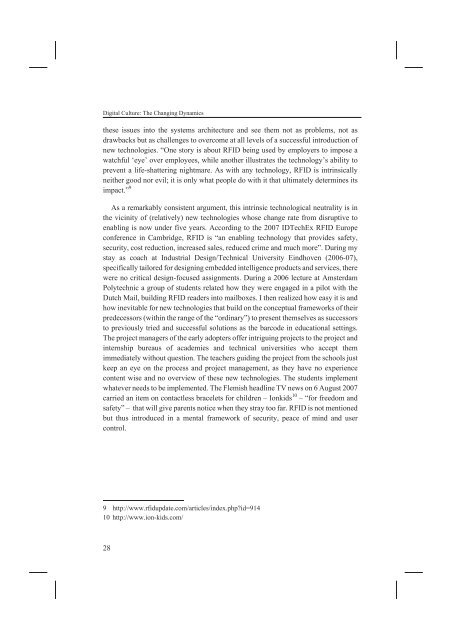D:\Documents and Settings\Ana\My Documents\Biserka-knjiga ...
D:\Documents and Settings\Ana\My Documents\Biserka-knjiga ...
D:\Documents and Settings\Ana\My Documents\Biserka-knjiga ...
You also want an ePaper? Increase the reach of your titles
YUMPU automatically turns print PDFs into web optimized ePapers that Google loves.
Digital Culture: The Changing Dynamics<br />
these issues into the systems architecture <strong>and</strong> see them not as problems, not as<br />
drawbacks but as challenges to overcome at all levels of a successful introduction of<br />
new technologies. “One story is about RFID being used by employers to impose a<br />
watchful ‘eye’ over employees, while another illustrates the technology’s ability to<br />
prevent a life-shattering nightmare. As with any technology, RFID is intrinsically<br />
neither good nor evil; it is only what people do with it that ultimately determines its<br />
impact.” 9<br />
As a remarkably consistent argument, this intrinsic technological neutrality is in<br />
the vicinity of (relatively) new technologies whose change rate from disruptive to<br />
enabling is now under five years. According to the 2007 IDTechEx RFID Europe<br />
conference in Cambridge, RFID is “an enabling technology that provides safety,<br />
security, cost reduction, increased sales, reduced crime <strong>and</strong> much more”. During my<br />
stay as coach at Industrial Design/Technical University Eindhoven (2006-07),<br />
specifically tailored for designing embedded intelligence products <strong>and</strong> services, there<br />
were no critical design-focused assignments. During a 2006 lecture at Amsterdam<br />
Polytechnic a group of students related how they were engaged in a pilot with the<br />
Dutch Mail, building RFID readers into mailboxes. I then realized how easy it is <strong>and</strong><br />
how inevitable for new technologies that build on the conceptual frameworks of their<br />
predecessors (within the range of the “ordinary”) to present themselves as successors<br />
to previously tried <strong>and</strong> successful solutions as the barcode in educational settings.<br />
The project managers of the early adopters offer intriguing projects to the project <strong>and</strong><br />
internship bureaus of academies <strong>and</strong> technical universities who accept them<br />
immediately without question. The teachers guiding the project from the schools just<br />
keep an eye on the process <strong>and</strong> project management, as they have no experience<br />
content wise <strong>and</strong> no overview of these new technologies. The students implement<br />
whatever needs to be implemented. The Flemish headline TV news on 6 August 2007<br />
carried an item on contactless bracelets for children – Ionkids 10 – “for freedom <strong>and</strong><br />
safety” – that will give parents notice when they stray too far. RFID is not mentioned<br />
but thus introduced in a mental framework of security, peace of mind <strong>and</strong> user<br />
control.<br />
9 http://www.rfidupdate.com/articles/index.php?id=914<br />
10 http://www.ion-kids.com/<br />
28



